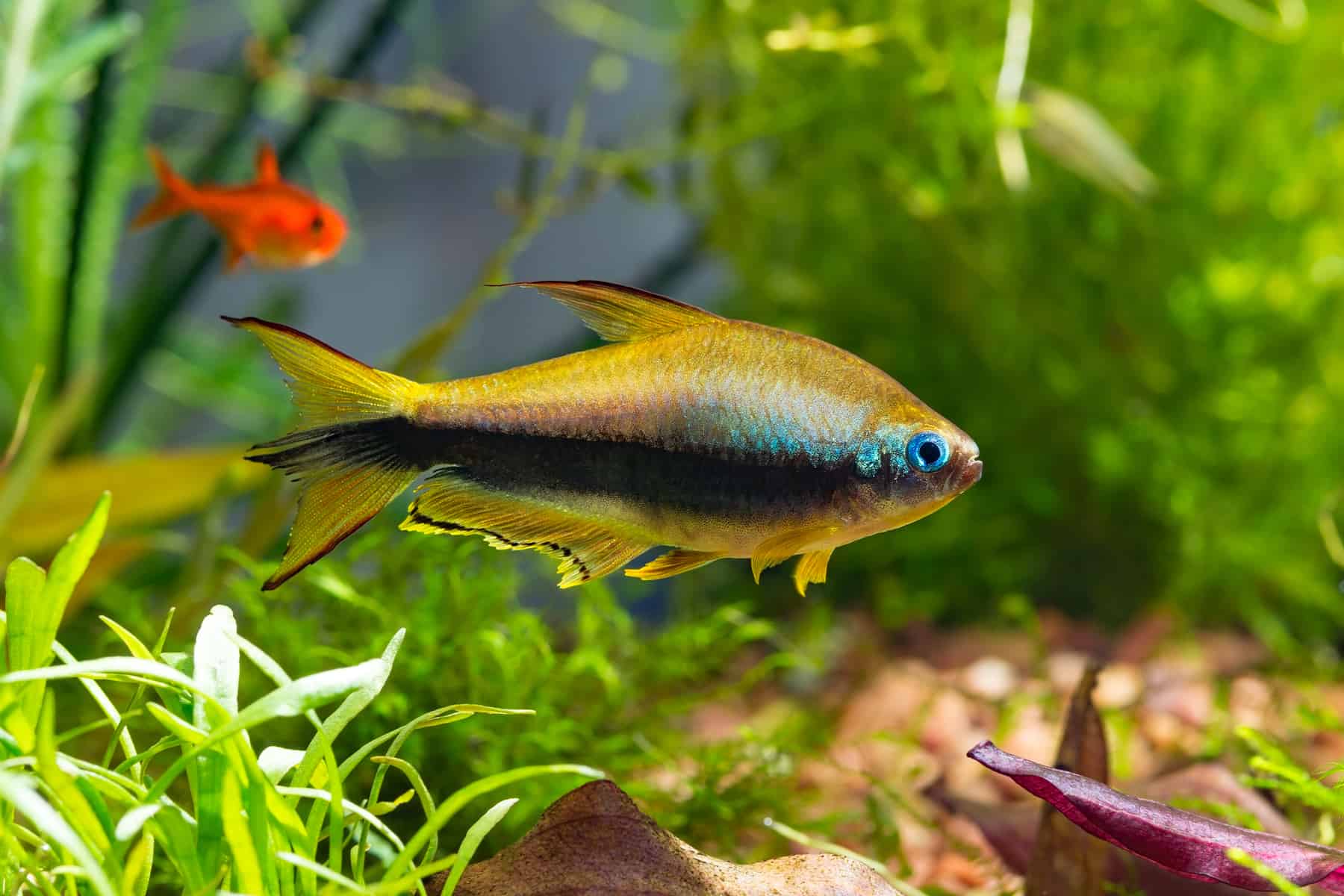If you’re looking to add to your tetra fish collection, the emperor tetra may be the crown jewel that your tank has been missing. These easy and inexpensive fish are a favorite among beginner aquarium keepers, but their simple elegance and beauty keep them appearing in longtime hobbyist tanks.
Keep reading for everything you need to know about emperor tetra care and keeping these freshwater fish in your own aquarium!
Name
Nematobrycon palmeri is commonly known as the emperor tetra and became popularized in the aquarium trade in 1960. There is currently only one other species in this genus: Nematobrycon lacortei.
Natural habitat
Emperor tetras originate from the slowing-moving rivers, tributaries, and blackwaters of the San Juan and Atrato river basins in western and southwestern Colombia. Here, the water remains soft and tropical with temperatures ranging between 73-81° F (23-27° C) and is more acidic with pH values between 5.0-7.5.
Identification
These little freshwater fish only reach a maximum of 3 inches (7.6 cm) when fully grown. Their perceived coloring largely depends on the aquarium lighting and their contrast with their surroundings; if the lighting is subdued, then emperor tetras seem to have a purple hue, whereas if the lighting is bright they look more yellow. A wide black stripe runs from their eye to their tail fin, and a secondary less-obvious blue stripe runs just above it. Their fins are also usually a beautifully transparent yellow.
It is very easy to tell male tetras apart from females. First, compare the eye colors between the two tetras; a male will have metallic blue eyes while the female will have the green. Males will also be larger, more colorful, and will have extended fins.
Emperors are commonly mislabeled as Inpaichthys kerri, also known as the purple emperor tetra or the blue emperor tetra. However, Nematobrycon palmeri is in a completely different genus and not even remotely related!
Emperor tetra tank requirements
Emperor tetras are an incredibly peaceful species of fish and are especially popular with beginner aquarium keepers due to their easy care and tank requirements. However, these fish are a shoaling fish, so they need to be kept in groups of at least 10. Because of this, an aquarium of at least 20 gallons (38 L) is recommended in order to keep your tetras happy.
These tetras do best in an aquarium that replicates the natural water conditions of the river basins in South America. This means that water temperature should be maintained between 73-81° F (23-27° C) with pH between 5.0-7.5.
These fish will especially feel at home in a moderately planted aquarium with a dark substrate where their colors will really pop. Leaf litter may be added for an even more natural effect and added medicinal properties.
Are emperor tetras aggressive?
Not at all! The only time they may become slightly territorial is if there are multiple males in the group and it is during a breeding period. However, if you have a large enough tank and enough hiding places are provided, your males should be able to swim away unscathed.
Emperor tetra tankmates
Because these tetras are such a calm and docile species, they won’t get along with more active and/or larger fish. While they may look like a larger fish due to their elongated bodies, their mouth is actually pretty small so they can’t easily eat other fish.
Your emperor tetra will get along best with other Nematobrycon palmeri and tetra species as well as danios, rasboras, and cories. While it is very unlikely that your tetra will go after an invertebrate if provided a high-quality diet, there is always the chance that it will prey on small snails and shrimp in your aquarium.

Emperor tetra diet
Emperors will eat anything that they come across: fish flakes, frozen foods, live foods, and freeze-dried foods. As middle and upper water column swimmers, your tetras will mainly eat towards the top of your aquarium although they may explore the bottom of the tank for leftover pieces of food.
If you really want their colors to shine, then providing high-quality foods will help really help bring your fish to its optimal health and appearance.
Breeding emperor tetras
The emperor tetra is not a difficult fish to breed at all; most, if not all, of the emperor tetras currently available, is actually domestically bred. If you want to try your hand at breeding emperor tetras, first start by removing the pair from the display tank and placing them in a separate tank that has some plants for your tetra to deposit eggs; you will know your fish are getting ready to spawn when females become plumper and males become more aggressive. Water parameters should match those of the original tank.
The female should lay anywhere between 50-100 eggs the next morning over the course of several hours. Once she has finished, remove the pair or they will eat the eggs and the fry. Within 24-36 hours, the eggs should hatch. Within 4-5 days, the fry will become free-swimming. Feed infusoria at first and then move onto microworms and brine shrimp once they start to grow a little bigger.
If your breeding pair hasn’t spawned after a couple of days, try a different pair. There is also always the chance that your tetras will spawn on their own in your tank, however, the eggs and fry will most likely be eaten.
Conclusion
Nematobrycon palmeri is an easy and beautiful fish fit for beginner and experienced fishkeepers and everyone in between! All you have to do is provide a good home and diet and your fish will thrive.
If you have any questions about keeping emperors or have experience with emperors in your own tank, don’t hesitate to leave a comment below!


























